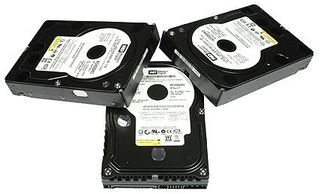Cheap RAID Ravages WD Raptor
Is The Raptor Still The Ideal Hard Drive?

Enthusiasts have an unwritten rule: Western Digital's WD1500 Raptor is the perfect desktop hard drive for those with performance ambitions. But the rule is difficult to follow for folks with budget restrictions, since most of us cannot afford $200 for a hard drive that stores a mere 150 GB. Is the Raptor still the best choice? Pricing hasn't changed for months, and you can easily get a 400 GB hard drive for half the money. Hence I believe it's time for RAID arrays to challenge the Raptor - again.
Hardware connoisseurs are very familiar with the Raptor, because it is the only 3.5" desktop hard drive that spins at 10,000 RPM. Most desktop drives rotate at 7,200 RPM and only expensive server hard drives run faster. The first WD Raptor at 36 and 74 GB was introduced three years ago. One year ago, the Western Digital Raptor-X was introduced, offering more performance and an optional clear cover, allowing enthusiasts to look inside the drive.
Ever since Western Digital released the Raptor, it has beaten all other 3.5" Serial ATA hard drives in the desktop space, despite originally being designed for entry-level servers. Please check out our Interactive 3.5" Hard Drive Charts to see how your hard drive stands against the Raptor drives.
The spindle speed of 10,000 RPM provides two significant advantages over slower drives. First, data transfer rates increase noticeably. While its maximum sequential read performance is no longer unmatched, the minimum transfer speed remains far superior to that of any 7,200 RPM drive. On the other hand, 10,000 RPM drives exhibit shorter rotational latencies, which means that the drive has to wait less time for data to pass the read/write heads once they were positioned.
The clear disadvantage of WD's Raptor is its hefty price tag of $200 or more - be ready to fork out $230 in retail stores. Other drawbacks are higher (although certainly not annoying) operating noise, and noticeably higher heat dissipation due to rotational friction. Real enthusiasts, however, will easily accept these drawbacks in exchange for maximum storage subsystem performance.
Consider the cost per gigabyte ratio, and the Raptor doesn't look that great anymore. $200+ will buy you at least two 400 GB hard drives, and gets you close to the $275 for a Seagate Barracuda 7,200.10 at 750 GB. At the low end you can get two 160 GB 7,200 RPM drives for $50 each, which will give you twice the capacity of a single Raptor at half the cost. Eventually, even hardcore enthusiasts have to ask themselves whether it still makes sense to purchase a WD Raptor, or if a RAID 0 setup with two 7,200 RPM drives is the better choice.
Though a RAID 0 array doesn't reduce access time, it does effectively double sequential transfer rates, because data is striped across both drives. The downside is an increased risk of a data loss, because one of the two hard drives failing will cause the whole array to be lost (although RAID recovery is possible). Many on-board storage controllers in upper mainstream and enthusiast class motherboards support RAID modes, which should make it very easy to set it up.
Stay on the Cutting Edge
Join the experts who read Tom's Hardware for the inside track on enthusiast PC tech news — and have for over 25 years. We'll send breaking news and in-depth reviews of CPUs, GPUs, AI, maker hardware and more straight to your inbox.
Current page: Is The Raptor Still The Ideal Hard Drive?
Next Page Fast Or Reasonable Hard Drives?-
malveaux Great review. This is a very important issue for some people. For me, I don't like getting the most expensive new edge tech when I can get less expensive options. RAID is a very simple technology, but it happens to work better because like all things, more heads do better than one in a thinking contest.Reply
I would have been really impressed if you guys took 4 drives at 7200rpm and low sizes, like 80gig drives, and did a RAID 0 with 4 drives and compared that speed with them. The access time would have been the same, but for the cost, the read and write would have been retarded high and made it look silly.
Then again, your electricity bill may be the difference in the cost, lol.
Most Popular

